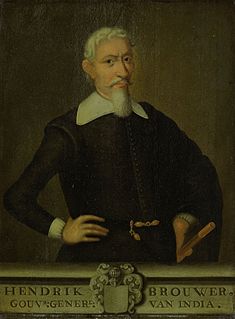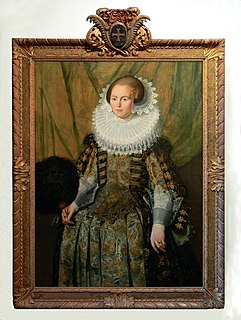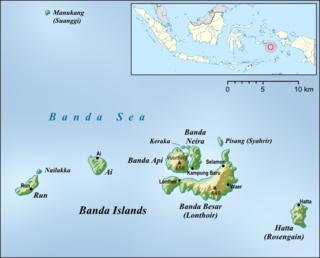Saartje Specx (1617–1636) was the daughter of Jacques Specx, governor of the North Quarter of the Dutch East India Company's (VOC's) Asian trading empire, and a Japanese concubine.
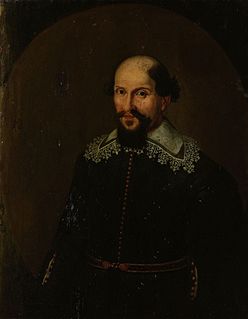
Jacques Specx was a Dutch merchant, who founded the trade on Japan and Korea in 1609. Jacques Specx received the support of William Adams to obtain extensive trading rights from Tokugawa Ieyasu, the shōgun emeritus, on August 24, 1609, which allowed him to establish a trading factory in Hirado on September 20, 1609. He was the interim governor in Batavia between 1629 and 1632. There his daughter Saartje Specx was involved in a scandal. Back home in Holland Specx became an art-collector.
The Dutch East India Company was an early megacorporation founded by a government-directed amalgamation of several rival Dutch trading companies (voorcompagnieën) in the early-17th century. It was originally established on March 20,1602 as a chartered company to trade with India and Indianised Southeast Asian countries when the Dutch government granted it a 21-year monopoly on the Dutch spice trade. The Company has been often labelled a trading company or sometimes a shipping company. However, the VOC was in fact a proto-conglomerate company, diversifying into multiple commercial and industrial activities such as international trade, shipbuilding, both production and trade of East Indian spices, Formosan sugarcane, and South African wine. The Company was a transcontinental employer and an early pioneer of outward foreign direct investment. The Company's investment projects helped raise the commercial and industrial potential of many underdeveloped or undeveloped regions of the world in the early modern period. In the early 1600s, by widely issuing bonds and shares of stock to the general public, the VOC became the world's first formally-listed public company. In other words, it was the first corporation to be listed on an official stock exchange. The VOC was influential in the rise of corporate-led globalization in the early modern period.
Saartje (Sara in English) was born at the Dutch trading base on the island of Hirado. In 1629, aged 12, she was living at Batavia in Java under the protection of Jan Coen, governor of the Dutch East Indies, and Eva Ment. There she fell in love with 15-year-old Pieter Cortenhoeff, a Eurasian standard-bearer in the VOC army, and was found making love to him in Coen's private apartment. When the Governor heard of this, a contemporary writer attested, "his face turned white and his chair and the table trembled." Coen had Cortenhoeff beheaded and had to be dissuaded from having Saartje drowned. Instead she was severely beaten in front of the Town Hall of Batavia.

The Netherlands is a country located mainly in Northwestern Europe. The European portion of the Netherlands consists of twelve separate provinces that border Germany to the east, Belgium to the south, and the North Sea to the northwest, with maritime borders in the North Sea with Belgium, Germany and the United Kingdom. Including three island territories in the Caribbean Sea—Bonaire, Sint Eustatius and Saba— it forms a constituent country of the Kingdom of the Netherlands. The official language is Dutch, but a secondary official language in the province of Friesland is West Frisian.

Batavia, also called Betawi in the city's local Malay vernacular, was the capital of the Dutch East Indies. The area corresponds to present-day Jakarta. Batavia can refer to the city proper, as well as its suburbs and hinterland, the Ommelanden, which included the much larger area of the Residency of Batavia in today's Indonesian provinces of DKI Jakarta, Banten and West Java. In Betawi Malay, the are constituting the former Residency of Batavia is called Tanah Betawi.

The Dutch East Indies was a Dutch colony consisting of what is now Indonesia. It was formed from the nationalised colonies of the Dutch East India Company, which came under the administration of the Dutch government in 1800.
Under the rules governing the VOC's Asian possessions, Saartje Specx, as a part-Asian, had no right to live in the Netherlands. On her father's return to Java she made a good marriage to Georgius Candidius, a Calvinist minister, and accompanied him to the Dutch trading base in Formosa (Taiwan), where she died, aged 19, in 1636.

Taiwan, officially the Republic of China (ROC), is a state in East Asia. Nearby states include the People's Republic of China (PRC) to the west, Japan to the northeast, and the Philippines to the south. It is the most populous state and largest economy that is not a member of the United Nations.
Jacob Cats wrote a pamphlet about the couple, which was sold 50,000 copies. In 1931, J. Slauerhoff wrote a play on Jan Pieterszoon Coen where the story was told again.
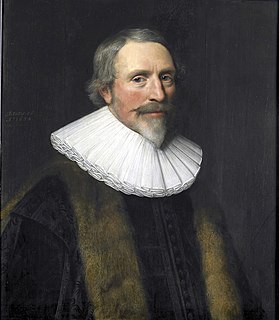
Jacob Cats was a Dutch poet, humorist, jurist and politician. He is most famous for his emblem books.
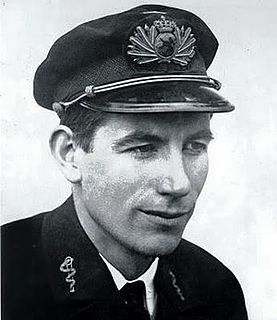
Jan Jacob Slauerhoff, who published as J. Slauerhoff, was a Dutch poet and novelist. He is considered one of the most important Dutch language writers.

Jan Pieterszoon Coen was an officer of the Dutch East India Company in Indonesia (VOC) in the early seventeenth century, holding two terms as its Governor-General of the Dutch East Indies. He was the founder of Batavia, the capital city of the Dutch East Indies.

